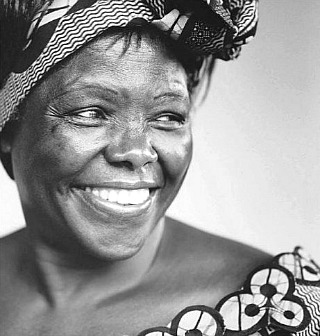In this morning’s class, we read the passages below from Wangari Maathai’s memoir, Unbowed. Leah then spoke about her country of Kenya and answered our many questions. She told us that when she was a girl, she planted a tree and so was part of Wangari’s Green Belt Movement. Wangari inspired her then, and Leah inspired us today.
Before the Europeans arrived, the peoples of Kenya did not look at trees and see timber, or at elephants and see commercial ivory stock, or at cheetahs and see beautiful skins for sale. But when Kenya was colonized and we encountered Europeans, with their knowledge, technology, understanding, religion, and culture—all of it new—we converted our values into a cash economy like theirs. Everything was now perceived as having monetary value. As we were to learn, if you can sell it, you can forget about protecting it. Using this analysis, we integrated the question of culture into our seminars and eventually wondered whether culture was the missing link in Africa’s development.
When I left the United States, I was taking back to Kenya five and a half years of higher education, as well as a belief that I should work hard, help the poor, and watch out for the weak and vulnerable. I knew that I wanted to teach in a university and share what I had learned about biology. I wanted to see my family and to start a family of my own.
It is fair to say that America transformed me: It made me into the person I am today. It taught me not to waste any opportunity and to do what can be done—and that there is a lot to do. The spirit of freedom and possibility that America nurtured in me made me want to foster the same in Kenya, and it was in this spirit that I returned home.
After the women had planted seedlings on their own farms, I suggested that they go to surrounding areas and convince others to plant trees. This was a breakthrough, because it was now communities empowering one another for their own needs and benefit. In this way, step by step, the process replicated itself several thousand times. As women and communities increased their efforts, we encouraged them to plant seedlings in rows of at least a thousand trees to form green “belts” that would restore to the earth its cloth of green. This is how the name Green Belt Movement began to be used. Not only did the “belts” hold the soil in place and provide shade and windbreaks but they also re-created habitat and enhanced the beauty of the landscape.
By now, nearly two thousand women’s groups were managing nurseries and planting and tending trees and more than a thousand green belts were being run by schools and students. Together, we had planted several million trees. Eventually, the Green Belt Movement would help establish more than six thousand nurseries, managed by six hundred community-based networks; involve several hundred thousand women, and many men, in its activities; and, by the early years of the twenty-first century, have planted more than thirty million trees in Kenya alone.Those of us who witness the degraded state of the environment and the suffering that comes with it cannot afford to be complacent. We continue to be restless. If we really carry the burden, we are driven to action. We cannot tire or give up. We owe it to the present and future generations of all species to rise up and walk!
